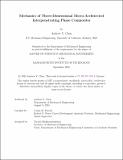Mechanics of Three-Dimensional Micro-Architected Interpenetrating Phase Composites
Author(s)
Chen, Andrew Y.
DownloadThesis PDF (105.7Mb)
Advisor
Portela, Carlos M.
Terms of use
Metadata
Show full item recordAbstract
The design of modern composite materials, as used in a wide range of engineering applications, is largely derived from a traditional framework based on laminates. While resulting in desirable strength and stiffness properties, the laminate-based structure leads to a high degree of anisotropy and unique failure modalities like interlaminar failure, limiting the performance of these composites under complex loading conditions. Meanwhile, recent work in the field of architected materials has yielded a thorough understanding of geometry-dependent material behavior, enabling the development of highly robust architectures with tunable (an)isotropy. However, such advances have focused primarily on describing the response of lightweight architected geometries comprised mostly of air. The effect of adding a load-bearing matrix is not well understood. Here we investigate the effect of geometry and constituent material properties on the mechanics of 3D-architected interpenetrating phase composite (IPC) materials, i.e., two-phase materials consisting of an architected structure surrounded by a matrix. Using computational homogenization, we first predict how resultant coupled stress states in the composite change with the material properties of each individual phase and contextualize the results within traditional stiffness scaling laws. We then demonstrate two robust fabrication pathways for realizing polymer- and carbon-based centimeter-scale architected IPCs with micro-scale features. Using these prototypes, we study the mechanical behavior of the fabricated composites under uniaxial compression, with particular emphasis on the non-linear and failure regimes. We show that independent of the material system, the presence of a load-bearing matrix distributes the stress in the composite, contributing to a high-strength, globally stretchingdominated failure behavior, regardless of nodal connectivity. Moreover, the development of a 3D, highly tortuous pathway for stress delays or prevents catastrophic failure of the traditionally brittle architecture phase, resulting in energy dissipation performance of the composite that exceeds the sum of its individual constituents. Finally, we demonstrate that the composite stress state can be architected using geometric design of the IPC and introduce an example of tunable mechanical response in an architected composite inspired by traditional auxetic metamaterials. Altogether, this work broadens our established understanding of the link between architecture and mechanical performance by considering the framework of interpenetrating phase composites, creating the foundation for a new class of strong, resilient, and programmable materials with architected stress states.
Date issued
2024-09Department
Massachusetts Institute of Technology. Department of Mechanical EngineeringPublisher
Massachusetts Institute of Technology